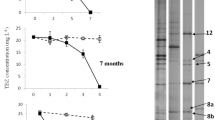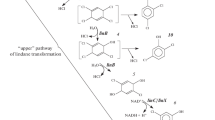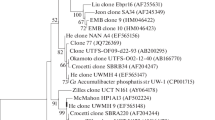Abstract
A Gram-negative, ethylenediaminetetraacetic acid (EDTA)-degrading bacterium (deposited at the German Culture Collection as strain DSM 9103) utilising EDTA as the only source of carbon, energy and nitrogen was isolated from a mixed EDTA-degrading population that was originally enriched in a column system from a mixture of activated sludge and soil. Chemotaxonomic analysis of quinones, polar lipids and fatty acids allowed allocation of the isolate to the α-subclass of Proteobacteria. 16S rDNA sequencing and phylogenetic analysis revealed highest similarity to the Mesorhizobium genus followed by the Aminobacter genus. However, the EDTA-degrading strain apparently forms a new branch within the Phyllobacteriaceae/Mesorhizobia family. Growth of the strain was rather slow not only on EDTA (μ max=0.05h−1) but also on other substrates. Classical substrate utilisation testing in batch culture suggested a quite restricted carbon source spectrum with only lactate, glutamate, and complexing agents chemically related to EDTA (nitrilotriacetate, iminodiacetate and ethylenediaminedisuccinate) supporting growth. However, when EDTA-limited continuous cultures of strain DSM 9103 were pulsed with fumarate, succinate, glucose or acetate, these substrates were assimilated immediately. Apparently, the strain can use a broader spectrum than indicated by traditional substrate testing techniques. The EDTA species CaEDTA and MgEDTA served as growth substrates of the strain because in the mineral medium employed EDTA was predicted to be mainly present in the form of these two complexes. The bacterium was not able to degrade Fe3+-complexed EDTA.
Similar content being viewed by others
References
Alder AC, Siegrist H, Gujer W & Giger W (1990) Behaviour of NTA and EDTA in biological wastewater treatment. Water Res. 24: 733–742
Auling G, Busse H-J, Egli T, El-Banna T & Stackebrandt E (1993) Description of the gramnegative, obligately aerobic, nitrilotriacetate (NTA)-utilizing bacteria Chelatobacter heintzii, gen. nov., sp. nov., and Chelatococcus asaccharovorans, gen. nov., sp. nov. Syst. Appl. Microbiol. 16: 104–112
BMU: Bundesminister für Umwelt, Naturschutz und Reaktorsicherheit, Germany (1991) Erklärung zur Reduzierung der Gewässerbelastung durch EDTA
Bohuslavek J, Payne J, Liu Y, Bolton H & Xun L (2001) Cloning, sequencing, and characterization of a gene cluster involved in EDTA degradation from the bacterium BNC1. Appl. Environ. Microbiol. 67: 688–695
Bucheli-Witschel M & Egli T (2001) Environmental fate and microbial degradation of aminopolycarboxylic acids. FEMS Microbiol. Rev. 25: 69–106
Egli T (1988) (An)aerobic breakdown of chelating agents used in household detergents. Microbiol. Sci. 5: 36–41
Egli T (1994) Biochemistry and physiology of the degradation of nitrilotriacetic acid and other complexing agents. In: Ratledge C (Ed) Biochemistry of Microbial Degradation (pp 179–195). Kluwer Academic Publishers, Dordrecht
Egli T, Weilenmann HU, El-Banna T & Auling G (1988) Gramnegative aerobic, nitrilotriacetate-utilizing bacteria from wastewater and soil. Syst. Appl. Microbiol. 10: 297–305
Gardiner J (1976) Complexation of trace metals by ethylenediaminetetraacetic acid (EDTA) in natural waters. Water Res. 10: 507–514
Gschwind N (1992) Biologischer Abbau von EDTA in einem Modellabwasser. gwf Wasser Abwasser 133: 546–549
Henneken L, Klüner T, Nörtemann B & Hempel DC (1994) Abbau von EDTA mit freien und immobilisierten Bakterien. gwf Wasser Abwasser 135: 354–358
Henneken L, Nörtemann B & Hempel DC (1995) Influence of physiological conditions on EDTA degradation. Appl. Microbiol. Biotechnol. 44: 190–197
Henneken L, Nörtemann B & Hempel DC (1998) Biological degradation of EDTA: Reaction kinetics and technical approach. J. Chem. Technol. Biotechnol. 73: 144–152
Houriet J-P (1996) NTA dans les eaux. Cahier de l'environnement 264. Office fédéral de l'environnement, des forêts et du paysage (OFEFP), Berne, Switzerland
Jones PW & Williams DR (2001) Speciation efficiency indices (SEI) and readily-biodegradable indices (RBI) for optimising ligand control of environmental and associated industrial processes. Int. J. Environ. Anal. Chem. 81: 73–88
Kaluza U, Klingelhöfer P & Taeger K (1998) Microbial degradation of EDTA in an industrial wastewater treatment plant. Water Res. 32: 2843–2845
Kämpfer P, Müller C, Mau M, Neef A, Auling G, Busse H-J, Osborn AM & Stolz A (1999) Description of Pseudoaminobacter gen. nov. with two new species, Pseudoaminobacter salicylatoxidans sp. nov. and Pseudoaminobacter defluvii sp. nov. Int. J. Syst. Bacteriol. 49: 887–897
Kaämpfer P, Neef A, Salkinoja-Salonen MS & Busse H-J (2002) Chelatobacter heintzii is a later subjective synonym of Aminobacter aminovorans. Int. J. Syst. Evol. Microbiol. 52: 835–839
Kari FG (1994) Umweltverhalten von Ethylendiamintetraacetat (EDTA) unter spezieller Berücksichtigung des photochemischen Abbaus. PhD thesis No. 10698, Swiss Federal Institute of Technology, Zürich, Switzerland
Kari FG & Giger W (1996) Speciation and fate of ethylenediaminetetraacetate (EDTA) in municipal wastewater treatment. Water Res. 30: 122–134
Klopp R & Pätsch B (1994) Organische Komplexbildner in Abwasser, Oberflächenwasser und Trinkwasser, dargestellt am Beispiel der Ruhr. Wasser & Boden: 32–37
Klüner T (1996) Chemie und Biochemie des mikrobiellen EDTA-Abbaus. PhD thesis, Universität-Gesmthochschule Paderborn, Germany
Klüner T, Hempel DC & Nörtemann B (1998) Metabolism of EDTA and its metal chelates by whole cells and cell-free extracts of strain BNC1. Appl. Microbiol. Biotechnol. 49: 194–201
Knobel H-R (1997) Genetic study of bacterial nitrilotriacetate degrading enzymes. PhD thesis No. 12146, Swiss Federal Institute of Technology, Zürich, Switzerland
Könen I (1997) Bestimmung von EDTA-Ersatzstoffen auf Aminopolycarbonsäurebasis. PhD thesis, TH Aachen, Germany
Kovaleva IB, Mitrofanova ND & Martynenko LI (1992) The structure of transition metal complexonates derived from ethylenediamine-(N,N')-disuccinic acid. Russ. J. Inorg. Chem. 37: 41–45
Lauff JJ, Steele DB, Coogan LA & Breitfeller JM (1990) Degradation of the ferric chelate of EDTA by a pure culture of an Agrobacterium sp. Appl. Environ. Microbiol. 56: 3346–3353
Müller B (1996) ChemEQL: A program to calculate chemical speciation equilibria, titrations, dissolutions, precipitation, adsorption, simple kinetics, and pX-pY diagrams. Kastanienbaum, Switzerland
Nörtemann B (1992) Total degradation of EDTA by mixed cultures and a bacterial isolate. Appl. Environ. Microbiol. 58: 671–676
Nowack B (1996) Behaviour of EDTA in groundwater — a study of the surface reactions of metal-EDTA complexes. PhD thesis No. 11392, Swiss Federal Institute of Technology, Zürich, Switzerland
Palumbo AV, Lee SY & Borman P (1994) The effect of media composition on EDTA degradation by Agrobacterium sp. Appl. Biochem. Biotechnol. 45/46: 811–822
Pfennig N, Widdel F & Trüper HG (1981) The dissimilatory sulfate-reducing bacteria. In: Starr MP, Stolp H, Trüper HG, Balows H & Schlegel HG (Eds) The Prokaryotes, Vol 1 (p 931). Springer Verlag, Berlin
Potthoff-Karl B, Greindl T & Oftring A (1996) Synthese abbaubarer Komplexbildner und ihre Anwendung in Waschmittel-und Reinigungsformulierungen. SÖFW-J. 122: 392–397
Satroutdinov AD, Dedyukhina EG, Chistyakova TI, Witschel M, Minkevich IG, Eroshin VK & Egli T (2000) Degradation of metal EDTA complexes by resting cells of the bacterial strain DSM 9103. Environ. Sci. Technol. 34: 1715–1720
Saunamäki R (1995) Treatability of wastewaters from totally chlorine-free bleaching. Tappi J. 78: 185–192
Scheiner D (1976) Determination of ammonia and Kjeldahl nitrogen by indophenol method. Water Res. 10: 31–36
Schneider RP, Zürcher F, Egli T & Hamer G (1988) Determination of nitrilotriacetate in biological matrices using ion exclusion chromatography. Anal. Biochem. 173: 278–284
Sykora V, Pitter P, Bittnerova I & Lederer T (2001) Biodegradability of ethylenediamine-based complexing agents. Water Res. 35: 2010–2016
Uetz TA (1992) Biochemistry of nitrilotriacetate degradation in obligately aerobic, Gram-negative bacteria. PhD thesis No. 9722, Swiss Federal Institute of Technology, Zürich, Switzerland
Wanner U, Kemmler J, Weilenmann H-U, Egli T, El-Banna T & Auling G (1990) Isolation and growth of a bacterium able to degrade nitrilotriacetic acid under denitrifying conditions. Biodegradation 1: 31–41
Witschel M (1999) Biochemical and physiological characterisation of a bacterial isolate able to grow with EDTA and other aminopolycarboxylic acids. PhD thesis No. 12967, Swiss Federal Institute of Technology, Zürich, Switzerland
Witschel M & Egli T (1998) Purification and characterization of a lyase from the EDTA-degrading bacterial strain DSM 9103 that catalyzes the splitting of [S,S]-ethylenediaminedisuccinate, a structural isomer of EDTA. Biodegradation 8: 419–428
Witschel M, Egli T, Zehnder AJB, Wehrli E & Spycher M (1999) Transport of EDTA into cells of the EDTA-degrading strain DSM 9103. Microbiology 154: 973–983
Witschel M, Nagel S & Egli T (1997) Identification and characterization of the two-enzyme system catalyzing the oxidation of EDTA in the EDTA-degrading bacterial strain DSM 9103. J. Bacteriol. 179: 6937–6943
Wolf K & Gilbert PA (1992) EDTA-Ethylenediaminetetraacetic acid. In: Hutzinger O (Ed) The Handbook of Environmental Chemistry, Vol 3 (pp 243–259). Springer, Berlin Heidelberg
Young JM, Kuykendall LD, Martinez-Romero E, Kerr A & Sawada H (2001) A revision of Rhizobium, with an emended description of the genus, and the inclusion of all species of Agrobacterium and Allorhizobiuzm undicola as new combinations: Rhizobium radiobacter, R. rhizogenes, R. rubi, R. undicola andR. vitis. Int. J. Syst. Evol. Microbiol. 51: 89–103
Author information
Authors and Affiliations
Rights and permissions
About this article
Cite this article
Weilenmann, HU., Engeli, B., Bucheli-Witschel, M. et al. Isolation and Growth Characteristics of an EDTA-degrading Member of the α-subclass of Proteobacteria . Biodegradation 15, 289–301 (2004). https://doi.org/10.1023/B:BIOD.0000042184.35056.ab
Issue Date:
DOI: https://doi.org/10.1023/B:BIOD.0000042184.35056.ab




